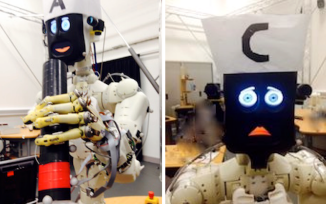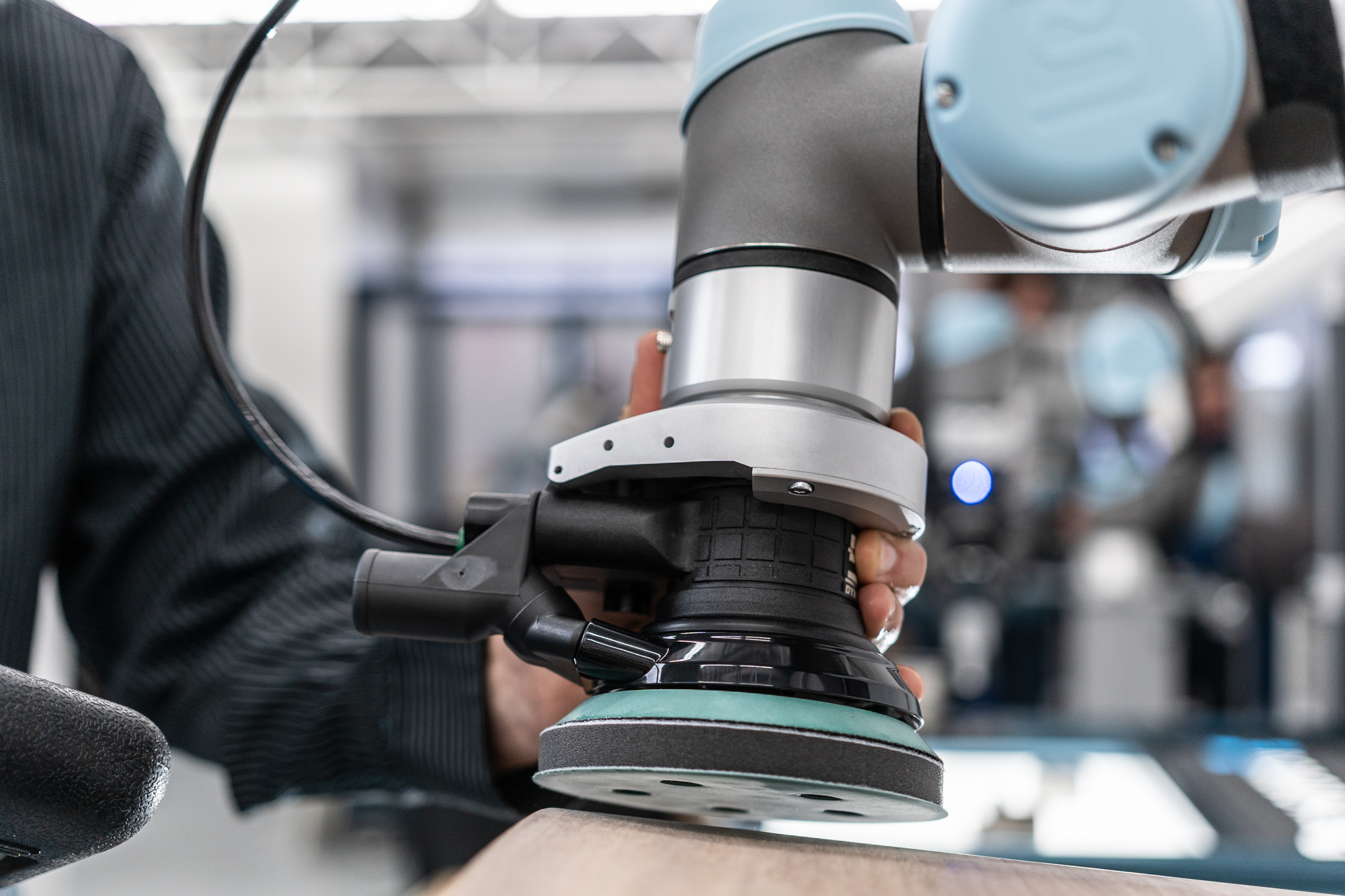What's New In Robotics This Week - Aug 26

Posted on Aug 26, 2016 7:00 AM. 8 min read time
People lie to robots; caterpillar-inspired bot; the robot economy; foosball bot; CNN Air launches; Mobileye-Delphi collab; bots boost logistics; and much more. Find out what's happening in our robotics universe this week. We hope that the news we have selected will interest and amuse you. Enjoy!
People Will Lie to Robots to Avoid Hurting Their Feelings, Study Says (Telegraph)
UK researchers have found that in some scenarios, people prefer an error prone, emotional robot to an efficient but inexpressive equivalent.
The study (PDF) reveals that some people will even lie about a robot's capabilities in order to avoid hurting the robot's feelings; or to be more precise, they lie in response to the robot displaying a sad face.

"Human-like attributes, such as regret, can be powerful tools in negating dissatisfaction," said Adrianna Hamacher, the researcher behind the project. "But we must identify with care which specific traits we want to focus on and replicate. If there are no ground rules then we may end up with robots with different personalities, just like the people designing them."
Back in Februrary we reported on Georgia Tech research which found that test subjects followed instructions from an “Emergency Guide Robot” even after the machine had proven itself unreliable – and after some participants were told that robot had broken down.
Human-robot interaction (HRI) is a fascinating area of study. One of HRI's most interesting features --a factor of the newness of robot technology-- is that humans and robots are slowly adapting to each other at the same time, albeit in a somewhat ad hoc manner.
Cobots in manufacturing are flexible and can operate alongside humans, but their capabilities in each cell are strictly defined. This isn't always the case in HRI research, which often looks at broader human-robot interactions in more complicated environments.
Nevertheless, we can expect more odd, interesting, and revealing research to emerge as humans --and the robots we design-- adjust to each other.
Soft Wriggling Caterpillar Robot Is Controlled by Light (Wired UK)
A team at the University of Warsaw has developed a 15 millimeter long, soft-bodied robot that can be controlled by laser beam.
Inspired by caterpillars, the robot can "wriggle forwards on a flat surface, as well as scale slopes, squeeze through tight gaps and even carry small loads."
"They used smart materials called Liquid Crystalline Elastomers that can change shape when exposed to light delivered by a spatially modulated laser beam.
The experts arranged these soft materials in a stripy pattern of 3D forms, so light-induced distortion, or movement, could occur without the need for tiny actuators hidden inside its body.
By controlling the "deformation pattern" or the way the material is distorted when it absorbs light, the researchers, joined by experts from LESN in Italy and the University of Cambridge, can make the bot move like a real caterpillar. They also showed the robot can push objects 10 times its own mass, and on challenging terrains."
The Robot Economy (Part 1): Interview with Alan Winfield (SPARC)
Must-read interview about the impact of robotics on the job market with Alan Winfield, professor at the Bristol Robotics Laboratory, and an expert in robot regulation and ethics.
Do you have concrete examples of where robots might impact the job market?
My bigger worry is AI, rather than physical robots. Knowledge workers (lawyers, call center workers, translators, data analysts, etc) are more at risk from AI than physical workers are from robots. A robot is a much more difficult technology to mature and deploy. And in almost every situation where we think robots might be useful, we find that what we really need are collaborative robots that work alongside humans. [emphasis mine]. That’s because most physical jobs that we do cannot be fully automated. The jobs that can be fully automated, for example assembly line manufacturing, have been already.
This Robot Can Beat You at Foosball (c|net)
In a move set to change dormitory and bar-life in many countries, Swiss roboticists have created a foosball-playing robot.
"A camera underneath the table takes 300 pictures a second and sends them to a computer that processes the ball's position on the table. Motors -- the kind used in manufacturing -- move the players and take shots. Those shots are faster, more powerful and more precise."
REPORT: Robots to Dramatically Boost Logistics by 2020 (Arabian Suppply Chain)
Six-fold growth in mobile robotics by 2020 will dramatically enhance Middle East and global business productivity, workplace safety, and daily lives, according to a new report by Frost & Sullivan, prepared in collaboration with GITEX Technology Week.
"Humanoid robots with advanced artificial intelligence are set to be a major leap forward in complementing people and enhancing efficiency in the workplace, especially in high-risk and fast-paced environments. As the Middle East's push for innovation continues, the region is primed to be a center of having robots transform the workplace. Lessons learned in retail could be extended to other verticals such as health care, hospitality, entertainment, and construction,” adds Paul Clarke [CTO at UK-based online-only grocery retailer Ocado.]
CNN Launches CNN Air (CNN)
The future of drone journalism received a boost this week, with CNN's announcement of the launch of a "designated Unmanned Aerial Systems (UAS) unit" with two full-time UAS operators designed "to fully integrate aerial imagery and reporting across all CNN networks and platforms."
CNN has been a leader in integrating drone technology into its operations. In 2015, the media giant was selected by the FAA as one of the first three industry “Pathfinders” to develop safe uses of UAS in newsgathering.
Mobileye, Delphi Team Up to Create Automated Driving System (Bloomberg)
Mobileye and Delphi Automotive are teaming up to develop a "low-cost system for self-driving vehicles that will be available to carmakers by the end of the decade," according to Kevin Clark, CEO of Delphi, speaking in a conference call this week.
Bloomberg reports that the companies plan to spend "hundreds of millions of dollars” to develop the system, which will be ready to sell by 2019."Their technology will rely less on costly lidar sensors, which bounce light off objects to assess shape and location, resulting in a more affordable system for car makers that might lack funding to develop the technology on their own, Amnon Shashua, chairman and chief technology officer of Israel-based Mobileye, said on the call.
“Together, we’re planning to build a new class of machine intelligence capable of mimicking true human driving capabilities,” Shashua said. “Our alliance provides a solution with a much smaller investment to our customers” to deploy fully autonomous cars."
Before I sign off for this week, it's been a while since we've included a real Robopocalypse!-style story in our weekly roundup, but this nightmare headline, courtesy of UK tabloid newspaper The Sun, was just too good to pass up: "Robots set to become CRIMINALS and cops will be powerless to stop them." Just don't say you weren't warned...
And Finally...
Robots ready to invade banks, shopping centres (The Australian)
An Arts Degree Might Just Robot-Proof Your Career (Gizmodo)
Will robots really replace humans? (Fourth Source)
Drone Patent Filed by Tesla in 1898 Surfaces Online (R&D Magazine)
Panasonic eyes trial sales of tomato-harvesting robot (The Japan Times)
Sex robots could soon be in brothels sooner than we think (News.com.au)
The robots are coming – and they are here to help (COST)
Panasonic eyes trial sales of tomato-harvesting robot (The Japan Times)
Co-Bots is the future of robotics (India Times)
A Chinese news outlet used an incredibly efficient “robot reporter” to cover the Olympics (QZ)









Leave a comment